Hole in the Clouds
Dec 7, 2009
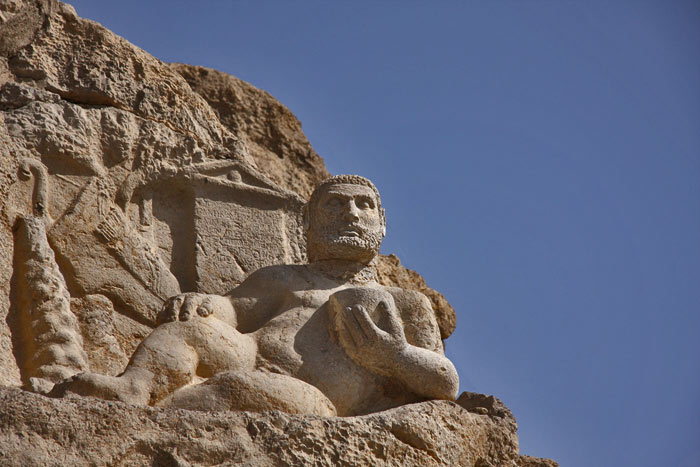
In 1958, road construction along this hillside in Bistoun, Iran uncovered a two-thousand-year-old carving of a a recumbent Hercules, in the nude. The Greek inscription on the tablet behind Hercules's shoulder helped date the sculpture to approximately 150 B.C.
There is a lion lying here alongside the hero, difficult to make out in this photo, except for the tail at upper left. Hercules is actually resting one arm on the lion's head. His weaponry--club and quiver--are leaned against the lion's rump. Hard to say what the man is drinking, but he's clearly been eating well.
Iran
Hercules
sculpture
Dec 8, 2009

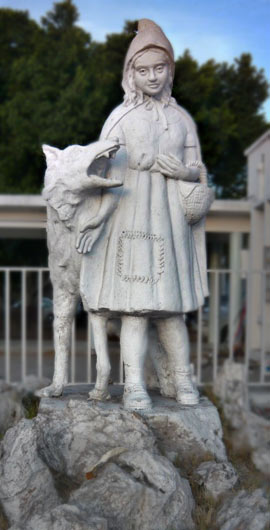
It seems straightforward enough: juxtapose innocence and danger, and there it is, Little Red Riding Hood. Also, I think, sculptors must like to do wolves. The bronze interpretation here is in Munich, the stone carving in Hermosillo, Mexico.
Germany
children
sculpture
Little Red Riding Hood
Hermosillo
Munich
Mexico
May 28, 2010
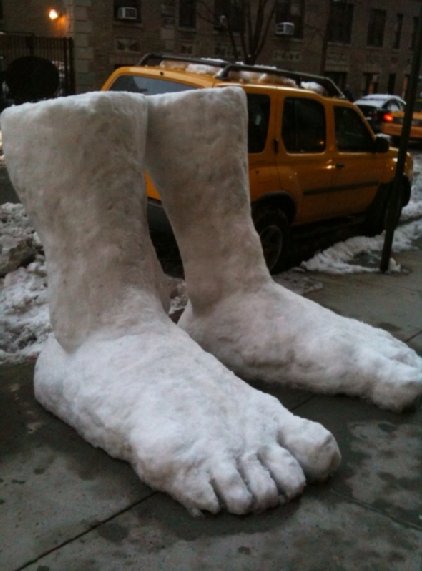
Sculptor Gerry Lynas prefers working in sand, but last February in New York he had no choice but to make do with snow. His "Two Feet of Snow" on W. 83rd Street in Manhattan was actually five and a half feet tall. It lasted only a day and a night; the next morning, one of the legs was in the gutter, perhaps from non-natural causes.
Lynas liked the consistency of that February 10 snowfall; he said he hadn't seen such nice, sticky sculpting snow in New York since 1977, when he built a thirty-foot wooly mammoth in Central Park.
Here's to a Memorial Day weekend of seasonably lousy snow.
New York
streetscape
winter
sculpture
snow
Gerry Lynas
(Thanks to Anna Singer)
Aug 27, 2011
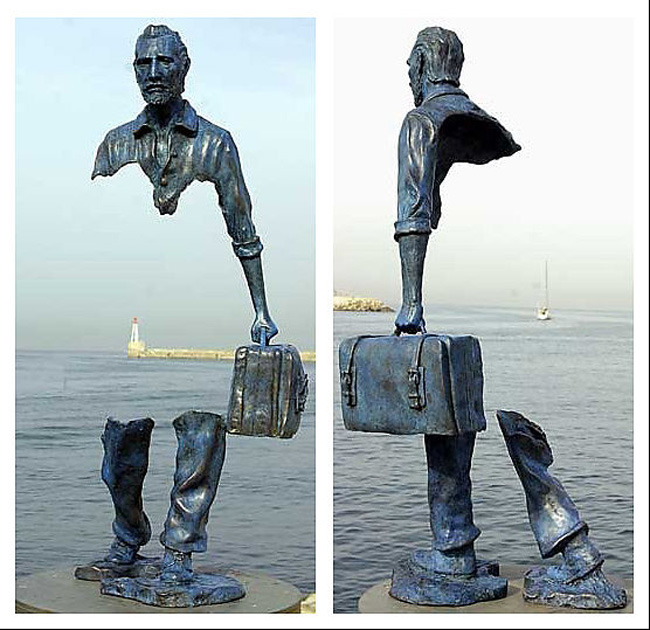
He is "Le Grand Van Gogh," cast in bronze by sculptor Bruno Catalano.
beach
art
sculpture
Bruno Catalano
van Gogh
bronze
holes
Sep 4, 2011
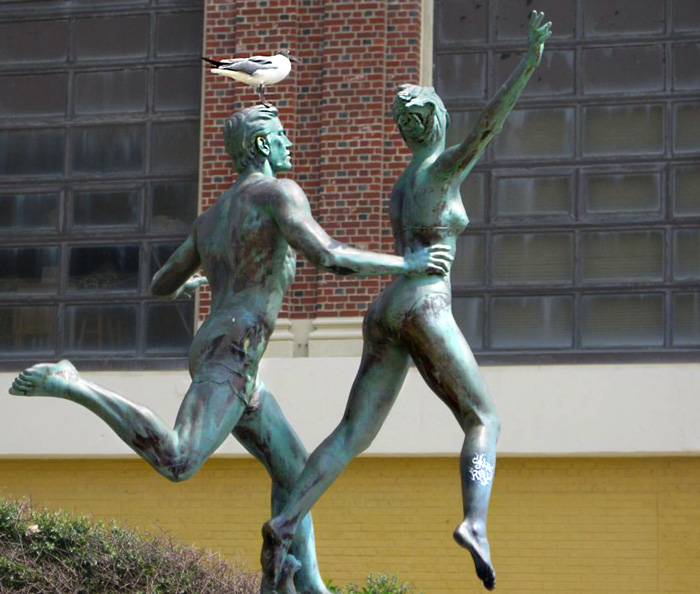 The bronze leg of the sculpted woman here appears to have graffiti on it. The bronze head of the man appears to have a seagull on it.
The bronze leg of the sculpted woman here appears to have graffiti on it. The bronze head of the man appears to have a seagull on it.
The people appear poised to run into the surf near the boardwalk in Atlantic City, New Jersey.
art
sculpture
New Jersey
Atlantic City
bronze
boardwalk
(Image credit: Richard S.)
Sep 28, 2011
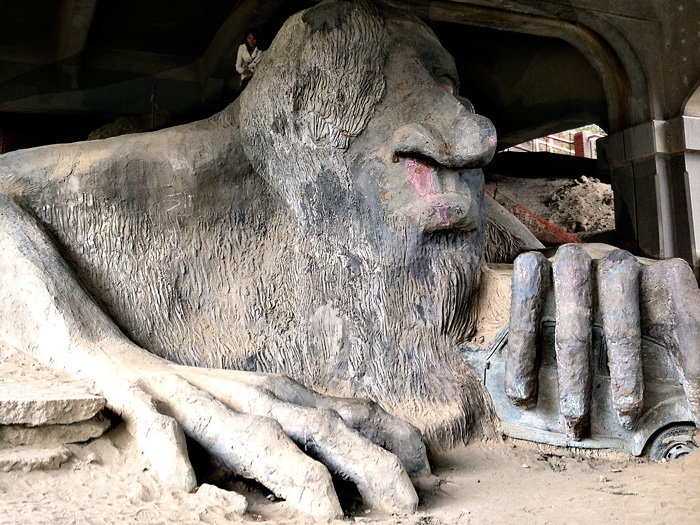 There's a troll underneath the Fremont bridge in Seattle, with a Volkswagen in its grip. The three billy goats gruff, in rusty cast iron, are grazing on a church lawn a couple of blocks away, at the corner of Troll Avenue and 35th Street.
There's a troll underneath the Fremont bridge in Seattle, with a Volkswagen in its grip. The three billy goats gruff, in rusty cast iron, are grazing on a church lawn a couple of blocks away, at the corner of Troll Avenue and 35th Street.
Washington
streetscape
sculpture
bridge
Seattle
troll
Volkswagen
Fremont
Nov 17, 2011
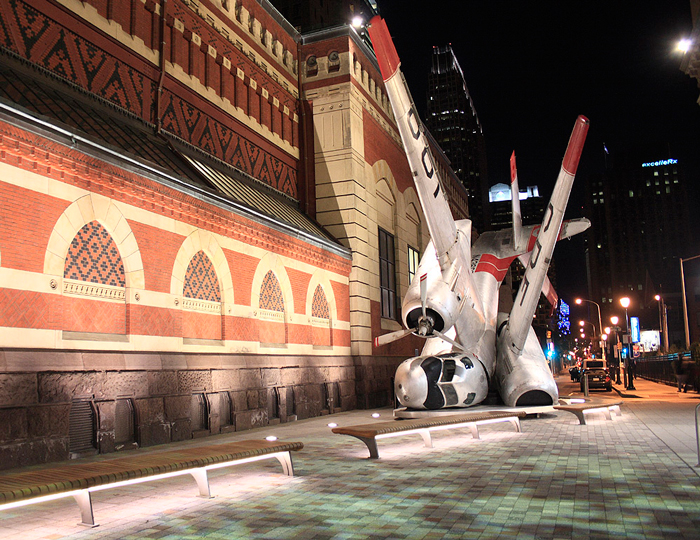 I don't know where Lenfest Plaza is in Philadelphia, but I gather that this airplane sculpture by Jordan Griska has been installed there recently, along with some Oldenburg paintbrushes. Guess I have to check it out.
I don't know where Lenfest Plaza is in Philadelphia, but I gather that this airplane sculpture by Jordan Griska has been installed there recently, along with some Oldenburg paintbrushes. Guess I have to check it out.
cityscape
streetscape
sculpture
Philadelphia
Jordan Griska
plane
Lenfest Plaza
(Image credit: Steve Ives)
Dec 18, 2011
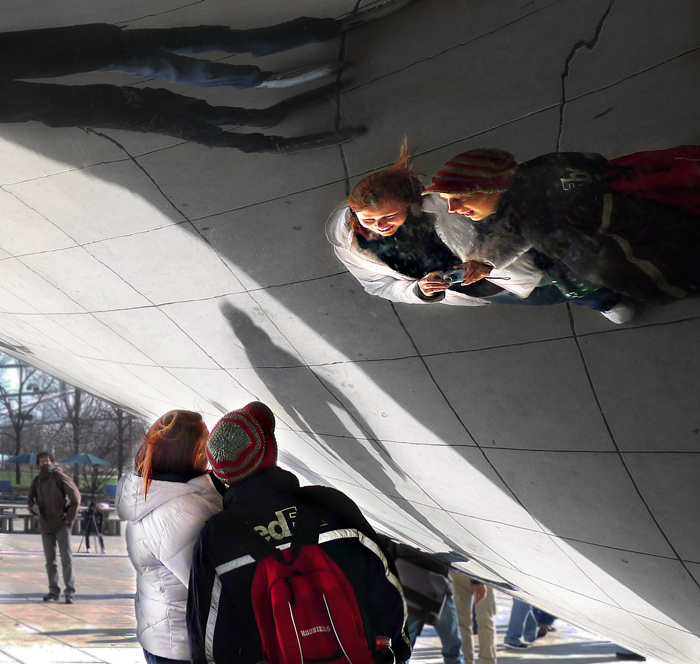 Visitors enjoy their reflections in the bean, in downtown Chicago's Millennium Park, near the waterfront. The couple pictured here can also be seen at lower right in the picture below, when they were first approaching the shiny thing and had not yet found themselves in it. But they're already there, if you look closely, along with the skyscrapers in the background and an ice skating rink in the middle distance.
Visitors enjoy their reflections in the bean, in downtown Chicago's Millennium Park, near the waterfront. The couple pictured here can also be seen at lower right in the picture below, when they were first approaching the shiny thing and had not yet found themselves in it. But they're already there, if you look closely, along with the skyscrapers in the background and an ice skating rink in the middle distance.

cityscape
Chicago
sculpture
skyline
Millennium Plaza
Grant Park
Cloud Gate
reflections
the bean
parkscape
Jan 21, 2012
 Ten years ago, an exhibition of work by the Colombian sculptor and painter Fernando Botero toured Europe, including a stop in the courtyard of the Cathedrale di Milano, as shown here. Next fall, a Botero exhibit will visit Bilbao, Spain, but the photo below taken in Bilbao last week features a sculpture that resembles the work of Botero in roundness alone.
Ten years ago, an exhibition of work by the Colombian sculptor and painter Fernando Botero toured Europe, including a stop in the courtyard of the Cathedrale di Milano, as shown here. Next fall, a Botero exhibit will visit Bilbao, Spain, but the photo below taken in Bilbao last week features a sculpture that resembles the work of Botero in roundness alone.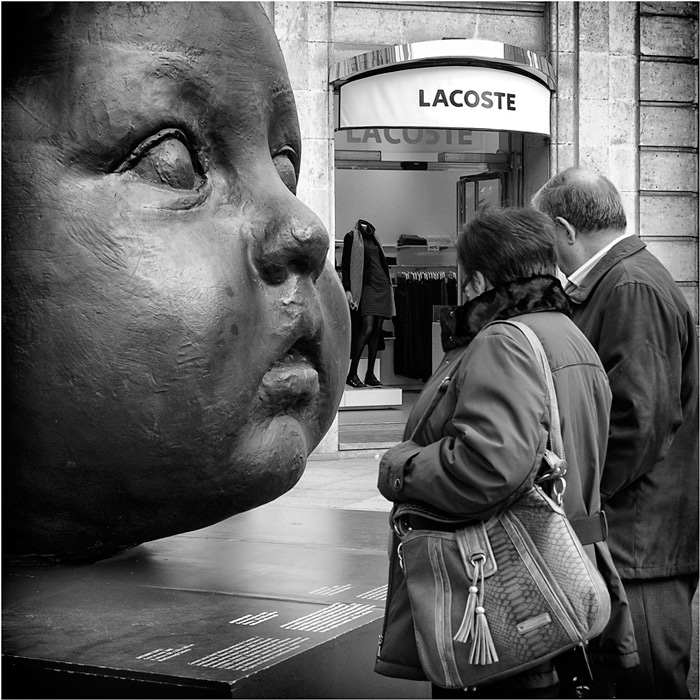
Spain
art
sculpture
architecture
Milan
Italy
shopping
Botero
Bilbao
(Image credits: top, Katrin Maldre; bottom, Luis Irisarri)
Nov 11, 2012
 They're asking 7000 Euros in Amsterdam for this trompe l'oeil coat made of wood.
They're asking 7000 Euros in Amsterdam for this trompe l'oeil coat made of wood.
Amsterdam
art
sculpture
trompe l'oeil
coat
(Image credit: Carol Fuchs)
Dec 4, 2012
 The United Nations Conference on Climate Change opened a few days ago in this brand new convention center in Doha, capital city of the Persian Gulf emirate of Qatar. The venue is "ironical," according to a columnist for India Today in Mumbai, because "talks about cutting down fossil fuel emissions and sustainable development are being held in the mecca of opulence and fossil fuels."
The United Nations Conference on Climate Change opened a few days ago in this brand new convention center in Doha, capital city of the Persian Gulf emirate of Qatar. The venue is "ironical," according to a columnist for India Today in Mumbai, because "talks about cutting down fossil fuel emissions and sustainable development are being held in the mecca of opulence and fossil fuels."
Qatar has the world's highest per capita income and also generates the world's largest per capita carbon footprint.
The "high-level" work of the conference is set to begin Tuesday, with attending nations each being given three minutes to address the group on climate-change and carbon-dioxide control issues. The conference banquet is set for Tuesday night; although the new building is said to offer banquet seating for 10,000, the climate change banquet will be held at Qatar's Islamic Museum in downtown Doha.
The name Doha is Arabic for "big tree," a theme much in evidence in the conference center architecture. In its central hall is French-American artist Louise Bourgeois's largest spider statue, Maman.
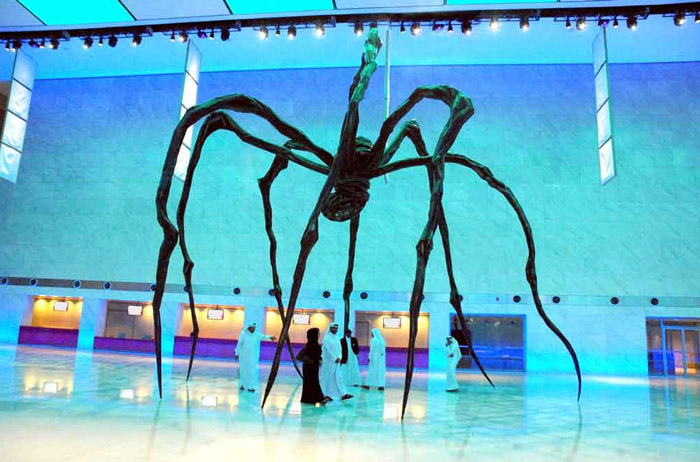
spider
sculpture
architecture
Louise Bourgeois
Qatar
Doha
Sep 7, 2013
 It must have been Oscar Wilde who said that you could never be overdressed or overeducated. In fact, he may be saying it just now, as he contemplates the world outside his childhood home in Dublin's Merrion Square, dressed to the nines from the neck down and wearing a becoming shade of snark across his face.
It must have been Oscar Wilde who said that you could never be overdressed or overeducated. In fact, he may be saying it just now, as he contemplates the world outside his childhood home in Dublin's Merrion Square, dressed to the nines from the neck down and wearing a becoming shade of snark across his face.
Sculptor Danny Osborne was as much prospector as artist for this project. He found the jade for Wilde's smoking jacket in extreme northern British Columbia, near the Yukon border. The pink collar and cuffs are from manganese-rich veins of zoisite in Norwegian shale.
The shimmery trousers are larkivite, also from Norway, a coarse-grained rock rich in anorthoclase feldspar, mined in Oslo Fjord. The well-polished shoes are black charnockite, from southern India; they get their shine from a distinctive kind of pyroxene known as hypersthene.
The 35-ton boulder that Wilde lounges on is Irish, but it's not in situ; Osborne found it in the Wicklow Mountains outside of Dublin.
The statue was sponsored by the Guinness Ireland Group and dedicated in 1997, ninety-seven years after Wilde's death at age 46.
It seemed appropriate, even necessary, to end this posting with a Wildeism. Settling on a single passage, however, proved ridiculously difficult, and it is certainly unfair to the man to reduce him to well-dressed witticism. But this line may do as well as any: "Every saint has a past, and every sinner has a future."
Or this: "Being natural is simply a pose."
geology
art
rocks
sculpture
Oscar Wilde
Dublin
Danny Osborne
(h/t: Janet Goldwater)
Oct 25, 2013
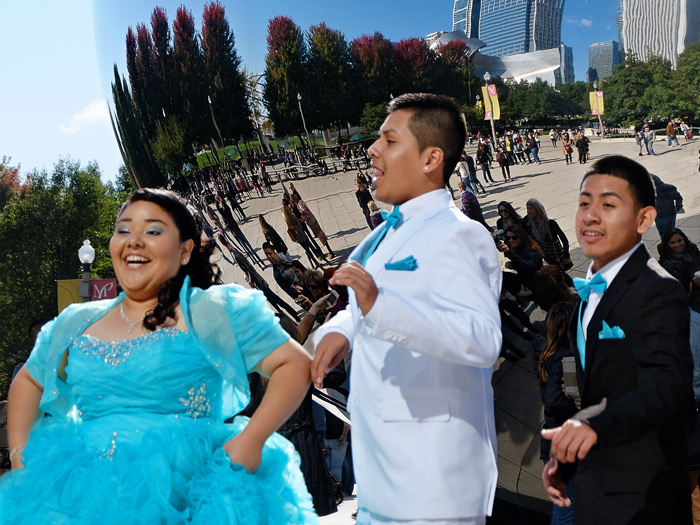 We went to Chicago last weekend for a family wedding, a proverbial happy occasion. The town was bustling with big goings-on; for example, the night before "our" event, there was another wedding at the same downtown hotel, a high-concept sort of wedding in which the bride and everyone else was wearing black. Also at our hotel, an MLS soccer team had taken up residence, visiting from Toronto for a game against the Chicago Fire (the Fire won, 1-0).
We went to Chicago last weekend for a family wedding, a proverbial happy occasion. The town was bustling with big goings-on; for example, the night before "our" event, there was another wedding at the same downtown hotel, a high-concept sort of wedding in which the bride and everyone else was wearing black. Also at our hotel, an MLS soccer team had taken up residence, visiting from Toronto for a game against the Chicago Fire (the Fire won, 1-0).
And then there was the happy occasion seen here, which included a Saturday morning photo session in front of Millennium Park's "Cloud Gate," aka the bean.
Seven years ago, when this tourist magnet first opened, photographers were required to get $350 permits and schedule their shoots in advance. Annish Kapoor, the artist who designed the bean, controlled his work's copyright and attempted to limit its reproduction. But the bean is nothing if not a photo op, and Kapoor quickly had to back off his restrictions; currently, you don't need a photo permit unless you are part of a film crew of ten or more people. The thousands of visitors every day who pull out their cellphones aren't breaking any laws.
The perfect shine and complex globular shape of the bean were inspired by drops of mercury, according to Kapoor, an Indian-born British sculptor. He thinks the popular name for his work, bean, is idiotic. He named it "Cloud Gate" because most of its polished stainless steel surface reflects, and distorts in odd ripply ways, sky and skyscrapers. Visitors are mostly interested, however, in how it reflects them, especially in the arched middle section, which reflects reflections of reflections in crazy, curvy ways much too complicated to figure out.
The plaza in which the bean sits is actually the roof of a restaurant and parking garage, and it had to be seriously reinforced to support 110 tons of highly polished stainless steel. After the reinforcing, computer-aided robots spent a year bending and welding together 168 steel plates, and after the welding, a crew of humans with sandpaper spent more than a year polishing the plates. After all the polishing, the welding seams became completely invisible, an accomplishment that won the work an Extraordinary Welding Award from the American Welding Society.
The lower part of the bean, where people leave fingerprints, is washed every day with Windex. The upper part, where air pollution and birds jeopardize the polish, is washed twice a year with liquid Tide.
If you want to rent it for a day just for yourself and your friends, the city charges $800,000. Twice so far, since opening day in 2006, people have paid that rent. The rest of the time, everybody's welcome, free of charge.
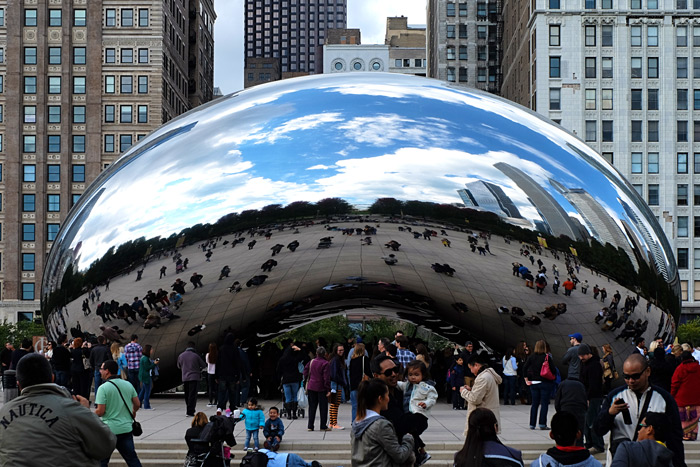
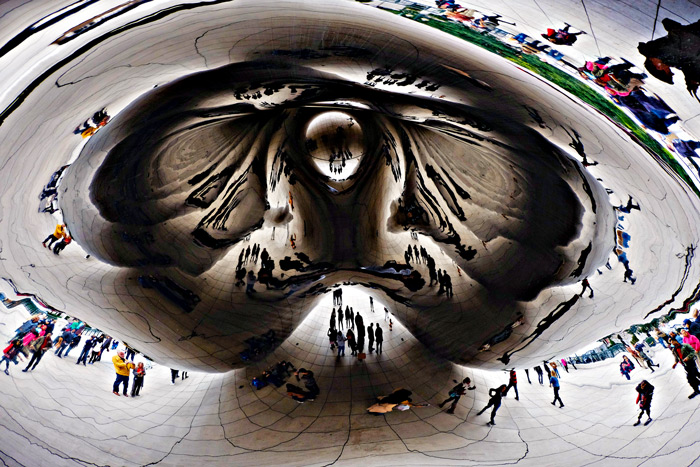
Chicago
wedding
sculpture
construction
photography
Cloud Gate
public art
Annish Kapoor
Millennium Park
(Image credits: Little Fuji)
Oct 27, 2013
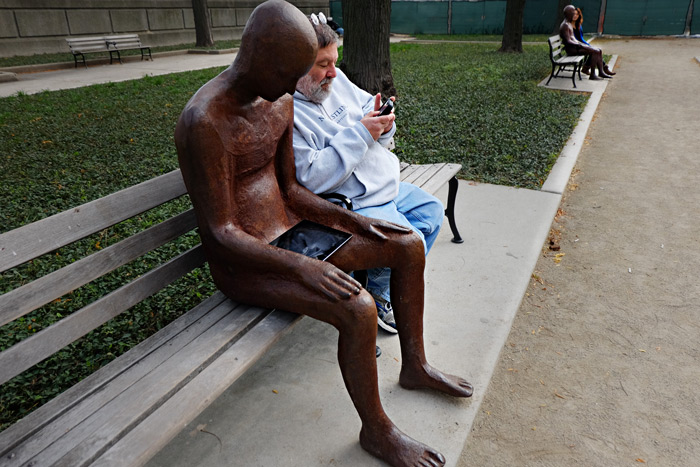
Icelandic sculptor Steinunn Thorarinsdottir populated this garden just south of the Art Institute with aluminum and cast iron people.

garden
Chicago
sculpture
trompe l'oeil
Norman
park
iphone
Segways
iPad
(Image credits: Little Fuji)
Jan 4, 2014
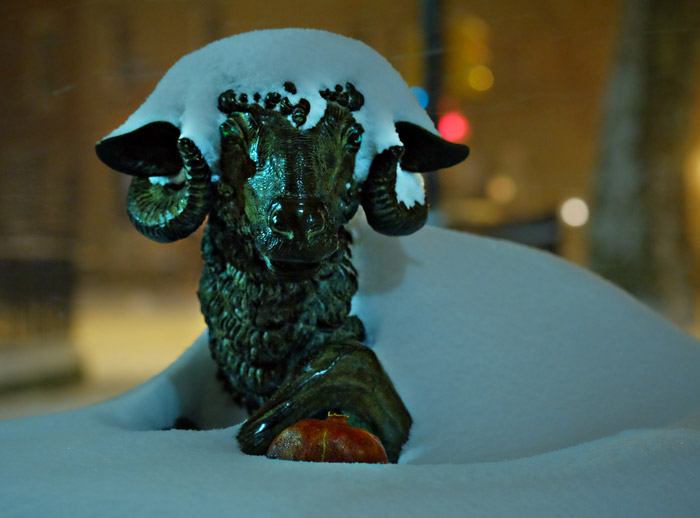 Last night, we saw a ram with a pomegranate in Fitler Square, Philadelphia.
Last night, we saw a ram with a pomegranate in Fitler Square, Philadelphia.
night
winter
sculpture
snow
Philadelphia
fruit
neighborhood
bronze
park
Fitler Square
ram
(Image credit: Hank Stein)
Dec 19, 2014
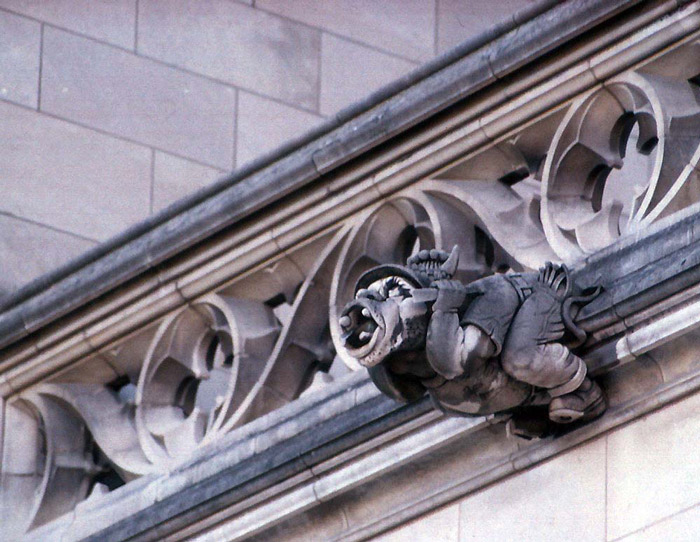 The twentieth-century stone carvers who worked on the National Cathedral in Washington, D.C., enriched the building with their own personal flourishes. The gargoyle above, for example, is a self-portrait with tools by carver Roger Morigi.
The twentieth-century stone carvers who worked on the National Cathedral in Washington, D.C., enriched the building with their own personal flourishes. The gargoyle above, for example, is a self-portrait with tools by carver Roger Morigi.
As the project neared completion in the 1980s, National Geographic World sponsored a competition for children to design the final few embellishments. Below is the Darth Vader grotesque, proposed for the competition by Christopher Rader of Kearney, Nebraska; it was sculpted by Jay Hall Carpenter and carved from limestone by Patrick Plunkett. Other sculptures from the contest include a raccoon, a girl with pigtails and braces, and a man with large teeth and an umbrella.

National Cathedral
sculpture
gargoyle
gothic
stone carving
grotesque
Feb 21, 2015
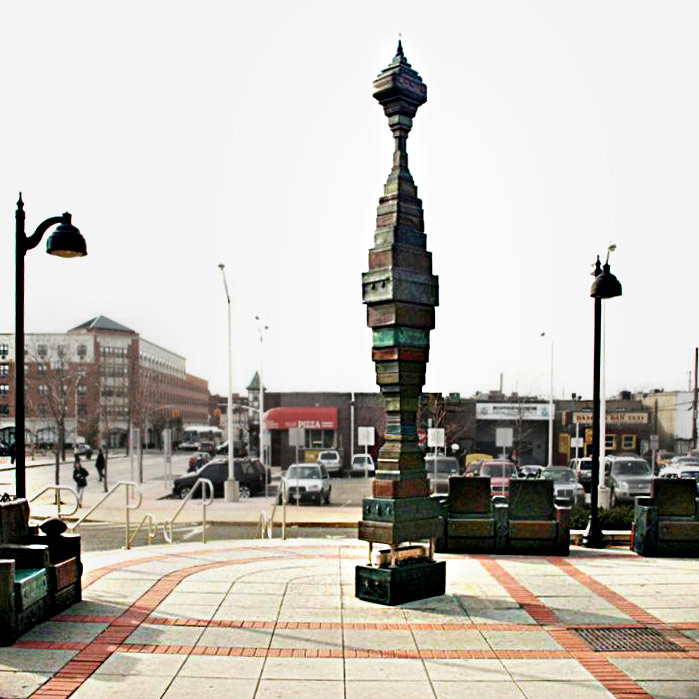 Ron Baron's "Lost and Found," bronze luggage and seating, was installed in 2010 in a plaza outside a new Long Island Railroad station in Hempstead, New York.
Ron Baron's "Lost and Found," bronze luggage and seating, was installed in 2010 in a plaza outside a new Long Island Railroad station in Hempstead, New York.
New York
art
sculpture
bronze
Ron Baron
plaza
Long Island Railroad
Hempstead
(h/t: Chris Williams)
Apr 4, 2016
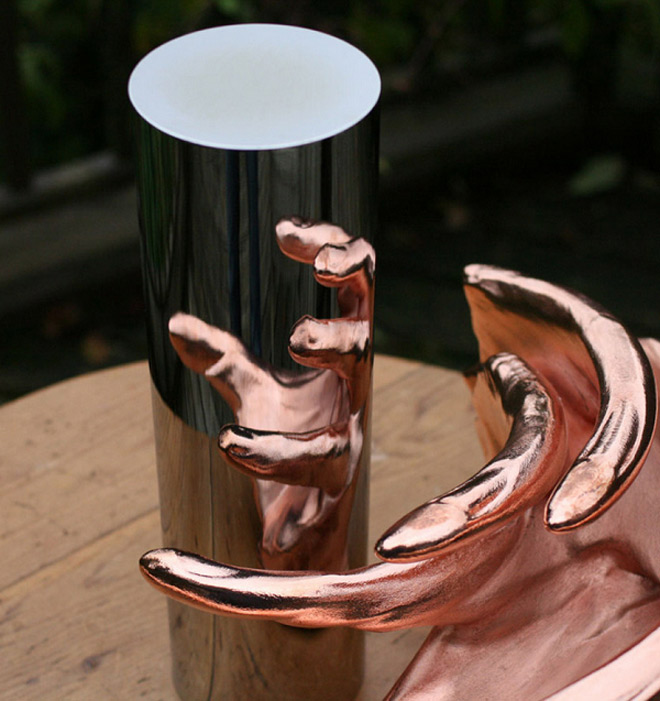
 Drawings that can be appreciated only by looking at them in a curved mirror have been around for hundreds of years, but three-dimensional sculpture that reveals itself only in a curved mirror is brand new, perhaps thirty or forty years old. It can't be done without modern computer power, calculating in three dimensions the projection in space of each point on the mirrored surface and generating the "solution" to the digital algorithms via a 3-D printer.
Drawings that can be appreciated only by looking at them in a curved mirror have been around for hundreds of years, but three-dimensional sculpture that reveals itself only in a curved mirror is brand new, perhaps thirty or forty years old. It can't be done without modern computer power, calculating in three dimensions the projection in space of each point on the mirrored surface and generating the "solution" to the digital algorithms via a 3-D printer.
There was often a practical reason for many of the old 2-D mirror drawings; they allowed the artist to ncorporate details into his work that were too racy or politically incorrect for a general audience but of considerable interest to those in the know, who might enjoy them by setting a polished cylinder in front of the painting.
The purpose of 3-D sculpture, on the other hand, such as these works by South African artist and software engineer Jonty Hurwitz, is less utilitarian, more a matter of artistic virtuosity. It's a cool thing that's really, really hard to do, but Hurwitz can pull it off.
sculpture
trompe l'oeil
optical illusion
mirror
3-D printer
(Art by Jonty Hurwitz)
Apr 25, 2016

In the mid-nineteenth century, the area around the northern Japanese city of Towada was designated as imperial ranchland, devoted to raising horses for the samurai cavalry.
The most famous of these horses was probably First Frost, which Emperor Hirohito rode for propaganda purposes during World War II. The U.S. Navy claimed to confiscate First Frost but actually left it with Hirorhito's personal property. Admiral "Bull" Halsey had promised to ride Hirorhito's horse when the Americans arrived in Tokyo, so another all-white horse was substituted for a ceremonial ride through town, for propaganda purposes.
Towada recalls its heritage with bronze horses spilling out onto a main street designated officially as Government Administration Road, nicknamed Horse Road. There are also 151 cherry trees along the road.
Japan
flowers
sculpture
spring
horses
bronze
springtime
Towada
cherry blossoms
Jun 8, 2016
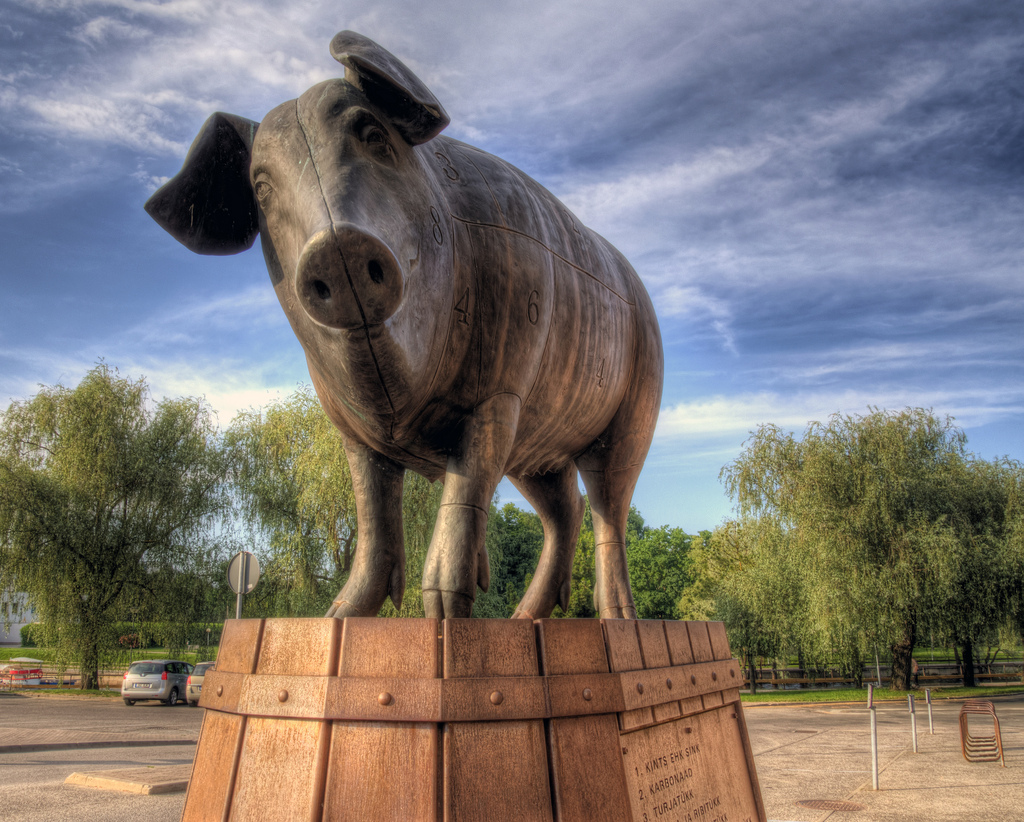 They go to market, of course. Above, in Tartu, Estonia; below, here in Philly at Reading Terminal Market.
They go to market, of course. Above, in Tartu, Estonia; below, here in Philly at Reading Terminal Market.
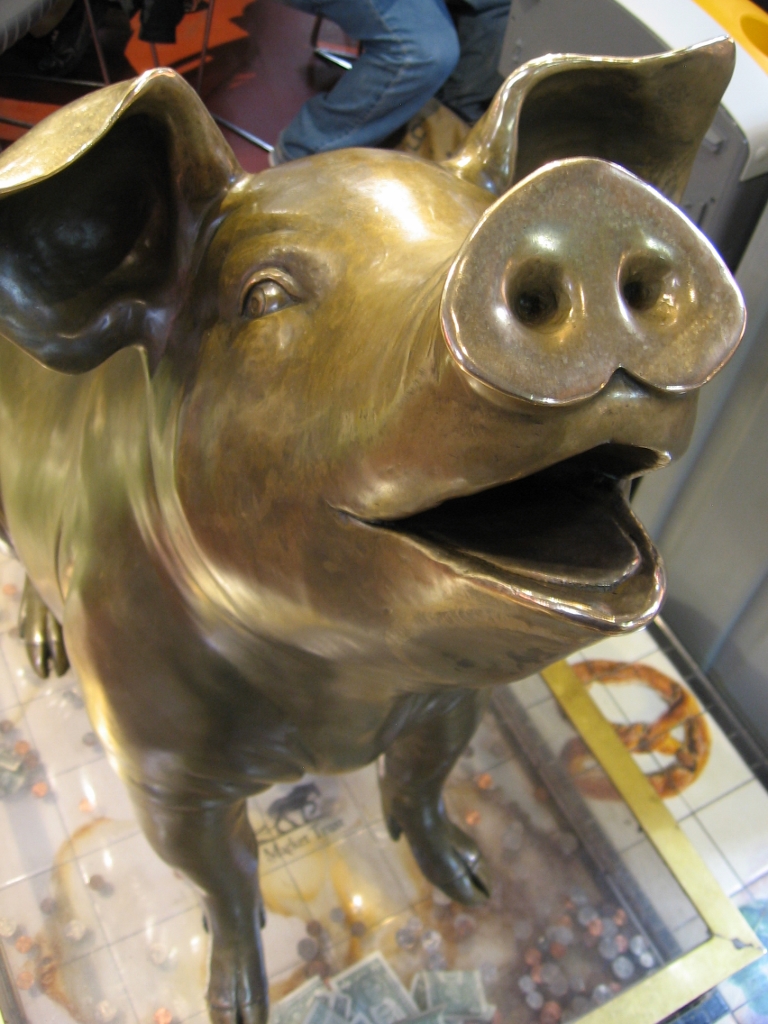
Estonia
animals
sculpture
Philadelphia
pigs
bronze
public art
Tartu
Reading Terminal Market
Jun 21, 2016
 Right outside Rosenbad, the prime minister's chancery in central Stockholm, sits this homeless woman with the face of a fox, huddled in a blanket, with a baby animal, perhaps a fox cub, perhaps a teddy bear, in her lap.
Right outside Rosenbad, the prime minister's chancery in central Stockholm, sits this homeless woman with the face of a fox, huddled in a blanket, with a baby animal, perhaps a fox cub, perhaps a teddy bear, in her lap.
The sculpture, a permanent installation on the granite sidewalk, is from artist Laura Ford's series Rag and Bone. In 2009, the city's newspaper by and for homeless people, known as Situation Sthlm, conducted a poll on where to put the statue; the winning location was this very public and political site.
The fox also has a single boot in her lap, into which passers by frequently drop euros. People who are uncertain about dontating to living, breathing homeless people somehow feel that leaving money for a bronze fox is a good thing to do. That's the world we live in.
Stockholm
Sweden
sculpture
bronze
homeless
fox and cub
street art
(Sculpture by Laura Ford)
Jun 20, 2016
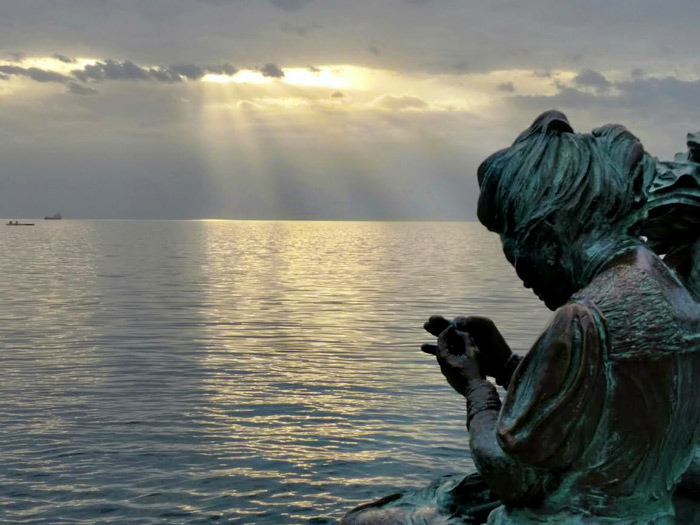 She sits by the waterfront in Trieste, Italy, apparently texting or checking her Facebook, but actually sewing, or maybe knitting.
She sits by the waterfront in Trieste, Italy, apparently texting or checking her Facebook, but actually sewing, or maybe knitting.
Not seen here: the other seamstress of Trieste, sitting and chatting alongside her.
art
sunset
sculpture
Italy
bronze
women
sewing
waterfront
working
Trieste
(Image credit: K. Maldre)
Feb 9, 2017

In 1986, the stairwell in this parking garage that connected the rooftop parking deck with the shopping streets alongside the garage was permanently locked. The problem, according to the St. Helens Reporter, the local newspaper, was "continued vandalism and anti-social behaviour."
Twenty years later, in 2006, the new staircase shown above was opened, spiraling around a polished steel "millennium needle" standing 20 meters high. The Reporter called it a "pole." The project, according to the Reporter, added an expensive "feature" of questionable value to the downtown area.
Downtown St. Helens, in the north of England east of Liverpool, hadn't had much in the way of expensive features for many years. A bustling mining and manufacturing center in the nineteenth century, it was rusting away of late, with only one factory remaining and a population of about 100,000. The whole region was depressed.
Google "St. Helens needle" and you come up with lots of stories about drug use and street crime, including one about a four-year-old child who had to go to the hospital after stepping on a hypodermic needle on her way home from the park.
Nevertheless, St. Helens city fathers put money into sprucing up the central shopping district, and some gentrification did in fact ensue. Several high-end restaurants moved into empty storefronts near the train station.
And eventually, there was pressure to reconnect the old parking garage more conveniently to the new "George Street Quarter." The needle was the result.
Like any good needle, it has a hole–many piercings, in fact, for lighting up near the point. But a real needle has its hole near the blunt end. This one is what it is.
For whatever it's worth, we note that this is actually the second Good Morning post about parking garages and European urban renewal. It happened in Skopje. And now in St. Helens.
sculpture
England
stairs
parking garage
urban renewal
St. Helens
(Image credit: Photogenics)
Apr 18, 2017
 The guard in the doorway of this room at the Seattle Art Museum said children smile and wiggle with excitement when they see this big mouse, about eight feet tall (photographer included for scale). There's a giant mouse in the house!
The guard in the doorway of this room at the Seattle Art Museum said children smile and wiggle with excitement when they see this big mouse, about eight feet tall (photographer included for scale). There's a giant mouse in the house!
But then the kids get a little closer and, um, uh. As seen below, the giant mouse isn't just in the house, he's in the bed. And there's a man in the bed, a life-sized man–but a life-sized man looks pretty puny when a giant mouse is walking all over him.
The guard says kids tend to back away when they realize what they're looking at. Some hide their faces and seem close to tears.
Adults, on the other hand, just keep on looking. What's to be scared of? Sticks and stones can break my bones, but art can never hurt me.
The sculptor is Katharina Fritsch, of Düsseldorf, Germany.

sculpture
Seattle Art Museum
nightmare
mouse
(Art by Katherina Fritsch)












 They're asking 7000 Euros in Amsterdam for this trompe l'oeil coat made of wood.
They're asking 7000 Euros in Amsterdam for this trompe l'oeil coat made of wood. The United Nations Conference on Climate Change opened a few days ago in this brand new convention center in Doha, capital city of the Persian Gulf emirate of Qatar. The venue is "ironical," according to a columnist for India Today in Mumbai, because "talks about cutting down fossil fuel emissions and sustainable development are being held in the mecca of opulence and fossil fuels."
The United Nations Conference on Climate Change opened a few days ago in this brand new convention center in Doha, capital city of the Persian Gulf emirate of Qatar. The venue is "ironical," according to a columnist for India Today in Mumbai, because "talks about cutting down fossil fuel emissions and sustainable development are being held in the mecca of opulence and fossil fuels."
 It must have been Oscar Wilde who said that you could never be overdressed or overeducated. In fact, he may be saying it just now, as he contemplates the world outside his childhood home in Dublin's Merrion Square, dressed to the nines from the neck down and wearing a becoming shade of snark across his face.
It must have been Oscar Wilde who said that you could never be overdressed or overeducated. In fact, he may be saying it just now, as he contemplates the world outside his childhood home in Dublin's Merrion Square, dressed to the nines from the neck down and wearing a becoming shade of snark across his face.







 Ron Baron's "Lost and Found," bronze luggage and seating, was installed in 2010 in a plaza outside a new Long Island Railroad station in Hempstead, New York.
Ron Baron's "Lost and Found," bronze luggage and seating, was installed in 2010 in a plaza outside a new Long Island Railroad station in Hempstead, New York.
 Drawings that can be appreciated only by looking at them in a curved mirror have been around for hundreds of years, but three-dimensional sculpture that reveals itself only in a curved mirror is brand new, perhaps thirty or forty years old. It can't be done without modern computer power, calculating in three dimensions the projection in space of each point on the mirrored surface and generating the "solution" to the digital algorithms via a 3-D printer.
Drawings that can be appreciated only by looking at them in a curved mirror have been around for hundreds of years, but three-dimensional sculpture that reveals itself only in a curved mirror is brand new, perhaps thirty or forty years old. It can't be done without modern computer power, calculating in three dimensions the projection in space of each point on the mirrored surface and generating the "solution" to the digital algorithms via a 3-D printer.






